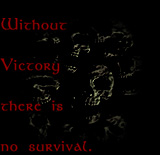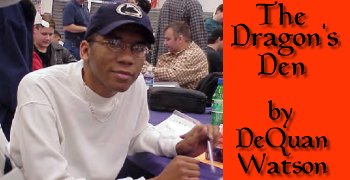|
|
|
|
|
|
|
|
|
|||
 |
||||||||||
|
|
|
|||||||||
 |
|
|||||||||
|
|
||||||||||
|
Stack'em Up! - Run the Turn
1.06.05 Every
once in a while, as a writer, we can get wrapped up in
our own topics. Our job is to guess what the readers
want to see. Sometimes we guess right. Sometimes we
guess wrong.
Over time, our reader base changes. In the world of Magic:the Gathering, the player base has changed pretty significantly in the past two years. With that being the case, we can sometimes take for granted that players know the rules really well. Sometimes, players can be reading stuff on the internet and not really be able to keep up with the sequence of events or the terminology. So, today I want to cover some things with you all regarding the stack. I know some people reference it, but don't REALLY know what it is. The following italicized portions are quoted from the MTG Rules FAQ. The Stack is a timing system. It's a zone of play, like your graveyard or your library. When a spell is announced, it cannot take its effect straight away. Instead, it's put on top of the stack, and other players are given the opportunity to respond to it with their own spells. The responses will resolve first, and when people have finished responding, eventually the original spell will resolve. (Note that this also applies to abilities.) The player who "has priority" at any particular time is the one who's currently allowed to add things to the stack. Here's a brief flowchart showing how the system works. What this says in simple terms is that no spell or ability "just happens." It has to be placed on the stack momentarily. While it is on the stack, players can add effects to that can potentially resolve before it and so on. In each step of the turn, the active player has priority to begin with. I: The player who has priority may announce a spell: he puts the spell onto the stack, chooses its mode and its targets, and pays its costs. If he chooses to do so, then he gets priority again- repeat this step. Otherwise, he "passes priority" to his opponent- go to [II]. When you play a spell, you must declare the targets for it and it's mode as it is announced and placed on the stack. If you are going to choose to target a creature or a player for two damage with your Shock, you must decide so when you cast it. If you are going to prevent three damage or gain three life with your healing salve, you must decide so when you cast it. You can add more spells to the stack on top of your own spells before passing priority if they are legal to be played (usually more instants or card abilities). II: Now, that player's opponent has priority, so he can play his own spells on the top of the stack. If he chooses to do so, then he'll be the one who passes priority again- we return to [I]. Otherwise, we go on to [III]. In this step, the opponent can then play spells or effects to the stack. This player follows the same rule. If this player chooses to add something to the stack, the first player will gain priority and we start all over again. If this players chooses to not add anything to the stack, then play progresses to step III. III: The players have both passed, so they've both declared that they're not going to respond to the current spell. If the stack is empty, then the current step of this turn will end. Otherwise, the top item of the stack resolves and is removed (in the case of an Instant or Sorcery it will go to the graveyard. Other types of spell will go into play, and pseudospells from abilities will be removed from the game). After that, the active player gets priority again. We return to I. First of all, the term pseudospell is used to describe an imaginary card placed on the stack to represent an effect or ability from a card. So don't let that scare you. If both player choose to pass on an empty stack, they proceed to the next step in the turn. Otherwise, the top most spell/effect (the last one added) to the stack will resolve. When the item resolves, it goes to it's appropriate place. If there is another item on the stack, the active player gets priority and can add more items to the stack. Follow the same rules from the previous two steps. And as a bonus feature, I am going to list the steps in each turn for you. Many players don't seem to understand exactly how a turn breaks down, so I am going to show this. Beginning Phase Untap Step Upkeep Step Draw Step Main Phase Combat Phase Beginning of Combat Step Declare Attackers Step Declare Blockers Step Combat Damage Step End of Combat Step End Phase End of Turn Step Cleanup Step The items lined up to the left are PHASES. The items tabbed over to the left are the STEPS that make up each PHASE. So, if you are in the Combat Damage you can still play spells that say "play during combat" for instance. After exchanging some e-mails and speaking with players at my store, it seems the toughest phase to breakdown in the combat phase. So, I will spend part of next week going over that. However, for now I want to leave you with a few bits of information to follow to help with you Magic games in the future. - Nothing "just happens" Every spell and every ability can be responded to. The only exception seems to be Morph. You can respond to an ability with caused by Morph, but you can't stop a creatures from morphing. - Add 'X' to the stack, not "in response..." For some reason I hear players repeated use the term, "in response." Most of the time, if they were truly responding with what they were trying to do, they wouldn't get the generated effect. You can always add something to the stack, but don't say in response. - Slow down Slow the game down. Your opponent will always get a chance to play a spell of effect. You will always get a chance to play one as well. So relax and slow down. - Learn to stack and unstack The best way to resolve things is to make a stack that you can physically see. In my store, I teach players to stack spells up in the middle of the table as they are played. If there is an effect, you can get something like an empty card sleeve to represent it on the stack. This way you can slowly tear down the stack and see what is next to be resolved. This will make some decisions easier when deciding what to play. Next week, we will take a closer look at the combat step and if there is time, we will cover some interesting situations with the stack. Until next time, DeQuan Watson PowrDragn at Pojo dot com a.k.a. PowrDragn www.thegamecloset.com
|
|||||||||

